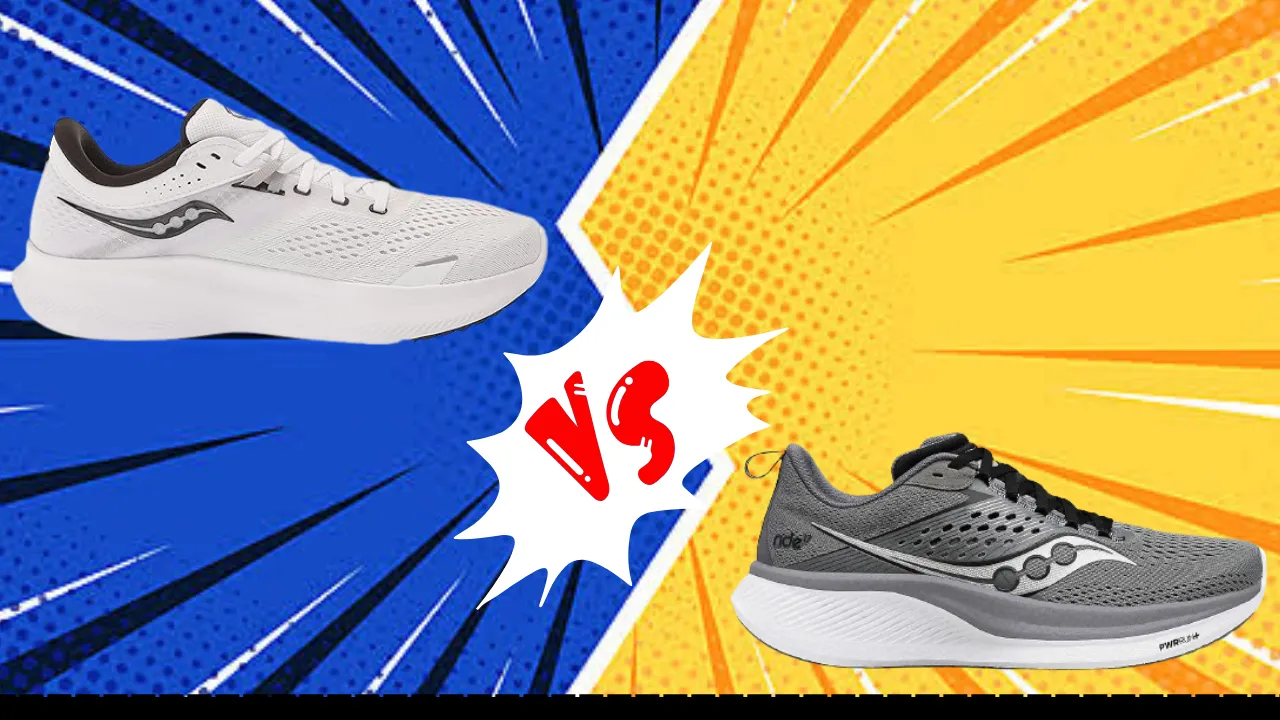Looking for a comfortable and versatile daily running shoe? The Saucony Ride series should be on your radar. The Saucony Ride 16 and Ride 17 are both cushioned neutral trainers suitable for runners of all levels.
But with an updated model now available, runners face an important question – should they opt for the tried-and-true Ride 16 or the latest Ride 17?
This in-depth comparison reviews key features, weighs performance factors, and highlights who each shoe is best suited for. Read on to determine whether the Ride 16 or Ride 17 is the better choice for you.
Similarities And Differences Between Saucony Ride 16 And Ride 17:
| Model | Ride 16 | Ride 17 |
|---|---|---|
| Launched In | 2023 | 2024 |
| Stability | Neutral | Neutral |
| Flexibility | Medium | Medium |
| Sizing | True to size | True to size |
| Weight | 9.2 oz (M) | 10.6 oz (M) |
| Cushion | PWRRUN | PWRRUN+ |
| Outsole | XT-900 Rubber | Carbon Rubber |
| Midsole | PWRRUN | PWRRUN+ |
| Upper | Engineered Mesh | Breathable Mesh |
| Retail Price | $140 | $140 |
Feature Comparision:
Material:
The Ride 16 features a breathable engineered mesh upper with minimal overlays. The midsole uses a full-length PWRRUN foam which provides responsive cushioning. The outsole uses durable XT-900 rubber in high-abrasion areas.
The engineered mesh upper provides a secure fit while maintaining breathability during runs. The PWRRUN foam in the midsole is designed to deliver an energetic, well-cushioned ride. Strategically placed along high-wear areas, the XT-900 rubber compound helps promote durability in the outsole.


The Ride 17 also has a breathable mesh upper, now with more perforations for added ventilation. The midsole is updated to PWRRUN+ foam which is softer and more resilient than the previous PWRRUN.
The outsole uses carbon rubber which should improve traction. The newly designed mesh upper has additional ventilating pores to allow increased airflow to the foot for dry comfort.
PWRRUN+ foam brings an enhanced level of responsiveness and shock absorption compared to standard PWRRUN foam. Carbon rubber in the outsole delivers improved grip and traction, giving runners confident footing in both wet and dry conditions.
Durability:
Both the Ride 16 and Ride 17 are built to last, with rugged outsoles and durable cushioning foams. The Ride 16 may have a slight edge in long-term durability thanks to its firmer PWRRUN midsole that is less prone to compression over time.
However, the Ride 17’s outsole rubber offers improved traction which can also enhance lifespan. The Ride 16’s dense PWRRUN foam retains its cushioning properties and structural integrity, even over hundreds of miles.
However, the sticky carbon rubber of the Ride 17 equips it with better traction, which ultimately promotes outsole durability by minimizing slippage.
Fit:
The Ride series is known for its comfortable, accommodating fit. Both shoes run true to size and come in a range of widths. The Ride 16 has a more traditional fit while the Ride 17’s upper is engineered for a more secure midfoot hold. Those with narrow or average-width feet may prefer the updated fit of the Ride 17.


With a seamless engineered mesh upper, the Ride 16 provides an adaptive fit that conforms naturally to the foot. But the Ride 17 integrates additional midfoot gating for a more dialed-in, secure feel during transitions. So runners with average or narrower feet may appreciate the improved midfoot lockdown of the Ride 17.
Stability:
As neutral trainers, neither model offers pronation control or stability features. However, the Ride 17 has a slightly wider base and a more substantial feel underfoot.
Mild overpronators might feel a bit more supported in the Ride 17. Both provide versatility for neutral runners. While not specifically classified as a stability shoe, the Ride 17’s wider footprint gives it a stable platform that could benefit mild overpronators.
The Ride 16 has a more traditional neutral shoe construction best suited for neutral runners. Both models deliver adaptable options for runners who don’t require pronation control.
Cushioning:
The main distinction is in the midsole foam. The PWRRUN+ in Ride 17 provides a softer, bouncier ride than the dense PWRRUN foam of Ride 16. Those wanting maximum cushion comfort will likely prefer the Ride 17.
However, some runners may favor the firmer, more responsive feel of the 16. With advanced PWRRUN+ cushioning, the Ride 17 gives runners enhanced shock absorption and energy return compared to the Ride 16’s firm PWRRUN foam.
The plush PWRRUN+ foam allows for supreme comfort over long distances. Yet some runners continue to appreciate the lower profile, and responsive ride quality of the Ride 16.
Value:
The Ride 16 and Ride 17 both have a retail price of $140. At the same cost, runners will need to compare the technologies and features of each to determine the better value.
The Ride 17 includes the enhanced PWRRUN+ midsole foam which provides a softer, bouncier ride compared to the firmer PWRRUN foam in the Ride 16. The Ride 17 also utilizes carbon rubber in the outsole over the Ride 16’s XT-900 rubber for improved traction.
For runners focused on plush cushioning and grip, the Ride 17 may be the better value option at $140. However, some runners may continue to favor the responsive ride and proven durability of the Ride 16, also a strong choice at this price point.
At the same $140 price, determining the better value will come down to personal preferences for cushioning, traction, and ride feel between the two neutral trainers.
Performance Comparision:
Walking:
For walking and casual use, the Ride 17’s softer cushioning absorbs impact better and offers increased comfort. The mesh upper with extra perforations also allows good airflow for walking shoes. The Ride 16 is firmer underfoot but also capable of walking.
Running:
For traditional running, some may prefer the Ride 16’s responsive and stable platform. But the Ride 17 offers improved shock attenuation and flexibility – both great assets for logging miles. The choice between the two may come down to cushioning preference.
Plantar Fasciitis:
The Ride 17’s well-cushioned PWRRUN+ foam softly absorbs heel and arch impacts, reducing strain on the plantar fascia. This makes the 17 a great option for those needing plush cushioning for plantar fasciitis. While the 16 is also a good choice, the 17’s enhanced cushion takes the lead.
Standing All Day:
With its soft foam and breathable upper, the Ride 17 helps alleviate foot fatigue for extended standing. The Ride 16 is also suitable but has a comparative lack of cushioning which can hinder all-day comfort. For long hours on your feet, the Ride 17 is likely the better pick.
Final verdict:
In the end, choosing between the Ride 16 and Ride 17 comes down to personal preferences and priorities.
For runners who prioritize plush cushioning and comfort, the Ride 17 is the clear choice. Its PWRRUN+ midsole provides enhanced shock absorption and energy return compared to the firmer Ride 16.
For those wanting a responsive, agile feel, the Ride 16 would likely be preferred. Its lower-profile midsole offers a more dynamic riding experience.
Both are durable, neutral shoes suitable for a wide range of training. The Ride 17 gets the nod for its superior comfort and flexible traction, while the 16 remains an excellent option for those wanting a more traditional feel.
Try them on back-to-back to see which ride resonates most. Either way, you’ll be rolling in quality with the Ride 16 or 17 on your feet.

